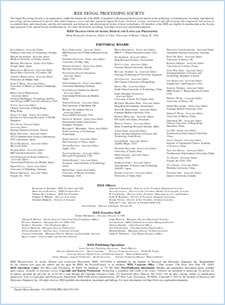- Our Story
- Publications & Resources
- Publications & Resources
- Publications
- IEEE Signal Processing Magazine
- IEEE Journal of Selected Topics in Signal Processing
- IEEE Signal Processing Letters
- IEEE Transactions on Computational Imaging
- IEEE Transactions on Image Processing
- IEEE Transactions on Information Forensics and Security
- IEEE Transactions on Multimedia
- IEEE Transactions on Signal and Information Processing over Networks
- IEEE Transactions on Signal Processing
- IEEE TCI
- IEEE TSIPN
- Data & Challenges
- Submit Manuscript
- Guidelines
- Information for Authors
- Special Issue Deadlines
- Overview Articles
- Top Accessed Articles
- SPS Newsletter
- SigPort
- SPS Resource Center
- Publications FAQ
- Blog
- News
- Dataset Papers
- Conferences & Events
- Community & Involvement
- Professional Development
- For Volunteers
- Information for Authors-OJSP
-
Home
Waveforms for Computing Over the Air: A groundbreaking approach that redefines data aggregation
Ode to Masterfully Written Textbooks: And remembering Simon Haykin [From the Editor]
Conferences Events IEEE Signal Processing Magazine IEEE SPL Article IEEE TIFS Article IEEE TMM Article IEEE TSP Article Jobs in Signal Processing Lectures Machine Learning Seasonal Schools Signal Processing News SPM Article SPS Distinguished Lectures SPS Newsletter Article SPS Webinar SPS Webinars SPS Webinar Series Webinar webinars -
Our Story
What is Signal Processing?

The technology we use, and even rely on, in our everyday lives –computers, radios, video, cell phones – is enabled by signal processing. Learn More » -
Publications & Resources
-
SPS Resources
- Signal Processing Magazine The premier publication of the society.
- SPS Newsletter Monthly updates in Signal Processing
- SPS Resource Center Online library of tutorials, lectures, and presentations.
- SigPort Online repository for reports, papers, and more.
- SPS Feed The latest news, events, and more from the world of Signal Processing.
-
SPS Resources
-
Conferences & Events
-
Community & Involvement
-
Membership
- Join SPS The IEEE Signal Processing Magazine, Conference, Discounts, Awards, Collaborations, and more!
- Chapter Locator Find your local chapter and connect with fellow industry professionals, academics and students
- Women in Signal Processing Networking and engagement opportunities for women across signal processing disciplines
- Students Scholarships, conference discounts, travel grants, SP Cup, VIP Cup, 5-MICC
- Young Professionals Career development opportunities, networking
- Get Involved
-
Technical Committees
- Applied Signal Processing Systems
- Audio and Acoustic Signal Processing
- Bio Imaging and Signal Processing
- Computational Imaging
- Image Video and Multidimensional Signal Processing
- Information Forensics and Security
- Machine Learning for Signal Processing
- Multimedia Signal Processing
- Sensor Array and Multichannel
- Signal Processing for Communication and Networking
- Signal Processing Theory and Methods
- Speech and Language Processing
- Technical Working Groups
- More TC Resources
-
Membership
-
Professional Development
-
Professional Development
- Signal Processing Mentorship Academy (SigMA) Program
- Micro Mentoring Experience Program (MiME)
- Distinguished Lecturer Program
- Distinguished Lecturers
- Distinguished Lecturer Nominations
- Past Lecturers
- Distinguished Industry Speaker Program
- Distinguished Industry Speakers
- Distinguished Industry Speaker Nominations
- Industry Resources
- IEEE Training Materials
- Jobs in Signal Processing: IEEE Job Site
-
Career Resources
- SPS Education Program Educational content in signal processing and related fields.
- Distinguished Lecturer Program Chapters have access to educators and authors in the fields of Signal Processing
- Job Opportunities Signal Processing and Technical Committee specific job opportunities
- Job Submission Form Employers may submit opportunities in the area of Signal Processing.
-
Professional Development
-
For Volunteers
-
For Board & Committee Members
- Board Agenda/Minutes* Agendas, minutes and supporting documentation for Board and Committee Members
- SPS Directory* Directory of volunteers, society and division directory for Board and Committee Members.
- Membership Development Reports* Insight into the Society’s month-over-month and year-over-year growths and declines for Board and Committee Members
-
For Board & Committee Members
Popular Pages
Today's:
- Information for Authors
- IEEE Signal Processing Letters
- Membership
- IEEE Transactions on Multimedia
- IEEE Transactions on Information Forensics and Security
- (ASRU 2025) 2025 IEEE Automatic Speech Recognition and Understanding Workshop
- IEEE Transactions on Image Processing
- Information for Authors-SPL
- Submit a Manuscript
- Call for Papers for ICASSP 2026 Now Open!
- Governance Documents
- Conference Call for Papers
- (ICME 2026) 2026 IEEE International Conference on Multimedia and Expo
- IEEE Transactions on Audio, Speech and Language Processing
- Editorial Board
All time:
- Information for Authors
- Submit a Manuscript
- IEEE Transactions on Image Processing
- IEEE Transactions on Information Forensics and Security
- IEEE Transactions on Multimedia
- IEEE Transactions on Audio, Speech and Language Processing
- IEEE Signal Processing Letters
- IEEE Transactions on Signal Processing
- Conferences & Events
- IEEE Journal of Selected Topics in Signal Processing
- Information for Authors-SPL
- Conference Call for Papers
- Signal Processing 101
- IEEE Signal Processing Magazine
- Guidelines
Last viewed:
- International Challenge on Activity Recognition (ActivityNet)
- (ASRU 2025) 2025 IEEE Automatic Speech Recognition and Understanding Workshop
- Information for Authors-SPM
- Submit a Manuscript
- Editorial Board Nominations
- IEEE Signal Processing Magazine
- Dataset Papers
- Post-doc in deep learning for biomedical image analysis
- Article Awards for the IEEE Transactions on Signal Processing
- About Open Journal of Signal Processing
- Series to Highlight Women in Signal Processing: Dr. Behnaz Ghoraani
- IEEE Transactions on Audio, Speech and Language Processing
- IEEE Transactions on Information Forensics and Security
- (ICASSP 2025) 2025 IEEE International Conference on Acoustics, Speech and Signal Processing
- Organize Local Initiatives
Hierarchical Regulated Iterative Network for Joint Task of Music Detection and Music Relative Loudness Estimation
You are here
Publications & Resources
For Authors
Top Reasons to Join SPS Today!
1. IEEE Signal Processing Magazine
2. Signal Processing Digital Library*
3. Inside Signal Processing Newsletter
4. SPS Resource Center
5. Career advancement & recognition
6. Discounts on conferences and publications
7. Professional networking
8. Communities for students, young professionals, and women
9. Volunteer opportunities
10. Coming soon! PDH/CEU credits
Click here to learn more.
Hierarchical Regulated Iterative Network for Joint Task of Music Detection and Music Relative Loudness Estimation
Music detection (MD) refers to the task of finding out whether a music event happens in an audio file and what time it starts and ends, i.e., splitting an audio recording and annotating each fragment as music or non-music. MD not only has the basic application in automatic retrieving and localizing audio data based on the type of content but also has a more practical application of monitoring music for copyright management. The practical application in the music industry is the royalty collection in broadcasting. As elaborated in [1]: the Austrian National Broadcasting Corporation (ORF) requires knowing where exactly the music appears in the soundtrack of TV production, and detecting the music is in the foreground or the background. ORF posed this requirement for the purpose of calculating the royalty fees, which are paid to a national agency according to certain rules. Ideally, the production team would provide a list of all the music segments occurring in TV production, but in reality, these lists are largely inaccurate. As a result, ORF has to guess the amount of music within a production more or less because manually annotating all productions is impossible. Also, the copyright fee will be different for music is used in the foreground or the background [2]. Hence, it is highly expected to develop method of music relative loudness estimation (MRLE), i.e., annotating each fragment as fg-music, bg-music, or non-music.
In the past, research mainly focused on the music/speech detection task, which is segmenting and annotating audio as music, speech, or noise. Early work [3] explored the distinguishable features between music and speech from the perspective of signal processing. Using these handcrafted features, later research [4]–[5][6] added subsequent classifiers to do music/speech detection. Recent works [7]–[8][9] focused on automatically-learned features from spectrogram images and used neural networks as classifiers. In contrast to simple music/speech detection task, the emphasis point of MD task is different: music is used to accentuate scenes, therefore speech and any noise signals might be present concurrently.
SPS Social Media
- IEEE SPS Facebook Page https://www.facebook.com/ieeeSPS
- IEEE SPS X Page https://x.com/IEEEsps
- IEEE SPS Instagram Page https://www.instagram.com/ieeesps/?hl=en
- IEEE SPS LinkedIn Page https://www.linkedin.com/company/ieeesps/
- IEEE SPS YouTube Channel https://www.youtube.com/ieeeSPS
Home | Sitemap | Contact | Accessibility | Nondiscrimination Policy | IEEE Ethics Reporting | IEEE Privacy Policy | Terms | Feedback
© Copyright 2025 IEEE - All rights reserved. Use of this website signifies your agreement to the IEEE Terms and Conditions.
A public charity, IEEE is the world's largest technical professional organization dedicated to advancing technology for the benefit of humanity.











